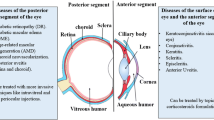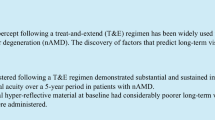Abstract
Purpose
To evaluate the efficacy of mineralocorticoid receptor antagonist (MRA) for patients with central serous chorioretinopathy (CSCR).
Methods
The Pubmed, Embase, and the Cochrane Central Register of Controlled Trials were comprehensively searched up to February 2020, to identify the studies comparing the efficacy of MRA with placebo/observation or photodynamic therapy (PDT) for CSCR. The primary outcomes were maximal subretinal fluid height and central macular thickness (CMT). The secondary outcomes included subfoveal choroidal thickness (SFCT) and best-corrected visual acuity (BCVA). Data of interest were extracted and analyzed by R version 3.6.0. The weighted mean difference and their 95% confidence intervals were used to assess the strength of the association.
Results
Ten studies including 284 affected eyes were involved, with 168 undergoing MRA treatment, 60 taking placebo/observation, and 56 receiving PDT. The pooling results showed that MRA was significantly more effective in resolving maximal subretinal fluid height (P < 0.01) and diminishing CMT (P < 0.01) than placebo/observation, while PDT could achieve significantly better CMT reduction than MRA (P = 0.03). For BCVA improvement and SFCT reduction, no statistical difference was detected among the groups of MRA, observation, placebo, or PDT (P > 0.05).
Conclusion
MRA is an effective therapy for the management of CSCR, which is only slightly inferior to PDT in terms of CMT reduction. For patients who could not afford PDT, MRA could function as an alternative treatment with acceptable efficacy and safety.




Similar content being viewed by others
Data Availability
The pooled analysis data used to support the findings of this study are available from the corresponding author upon request.
References
Kitzmann AS, Pulido JS, Diehl NN, Hodge DO, Burke JP (2008) The incidence of central serous chorioretinopathy in Olmsted County, Minnesota, 1980–2002. Ophthalmology 115(1):169–173
Yu J, Jiang C, Xu G (2019) Correlations between changes in photoreceptor layer and other clinical characteristics in central serous chorioretinopathy. Retina 39(6):1110–1116
Liew G, Quin G, Gillies M, Fraser-Bell S (2013) Central serous chorioretinopathy: a review of epidemiology and pathophysiology. Clin Exp Ophthalmol 41(2):201–214
Sartini F, Figus M, Nardi M, Casini G, Posarelli C (2019) Non-resolving, recurrent and chronic central serous chorioretinopathy: available treatment options. Eye (Lond) 33(7):1035–1043
Nicholson BP, Atchison E, Idris AA, Bakri SJ (2018) Central serous chorioretinopathy and glucocorticoids: an update on evidence for association. Surv Ophthalmol 63(1):1–8
Prunte C, Flammer J (1996) Choroidal capillary and venous congestion in central serous chorioretinopathy. Am J Ophthalmol 121(1):26–34
Zhao M, Celerier I, Bousquet E, Jeanny JC, Jonet L, Savoldelli M et al (2012) Mineralocorticoid receptor is involved in rat and human ocular chorioretinopathy. J Clin Invest 122(7):2672–2679
Daruich A, Matet A, Dirani A, Bousquet E, Zhao M, Farman N et al (2015) Central serous chorioretinopathy: recent findings and new physiopathology hypothesis. Prog Retin Eye Res 48:82–118
Rajesh B, Agrawal H, Peguda HK, Chhablani J (2018) Predictors of outcome during eplerenone therapy in chronic central serous chorioretinopathy: a prospective, Open-Label pilot clinical study. Ophthalmic Surg Lasers Imaging Retina 49(7):479–486
Sacconi R, Baldin G, Carnevali A, Querques L, Rabiolo A, Marchini G et al (2018) Response of central serous chorioretinopathy evaluated by multimodal retinal imaging. Eye (Lond) 32(4):734–742
Gergely R, Kovacs I, Schneider M, Resch M, Papp A, Recsan Z et al (2017) Mineralocorticoid receptor antagonist treatment in bilateral chronic central serous chorioretinopathy: a comparative study of exudative and nonexudative fellow eyes. Retina 37(6):1084–1091
Herold TR, Rist K, Priglinger SG, Ulbig MW, Wolf A (2017) Long-term results and recurrence rates after spironolactone treatment in non-resolving central serous chorio-retinopathy (CSCR). Graefes Arch Clin Exp Ophthalmol 255(2):221–229
Cakir B, Fischer F, Ehlken C, Buhler A, Stahl A, Schlunck G et al (2016) Clinical experience with eplerenone to treat chronic central serous chorioretinopathy. Graefes Arch Clin Exp Ophthalmol 254(11):2151–2157
Moher D, Liberati A, Tetzlaff J, Altman DG (2009) Preferred reporting items for systematic reviews and meta-analyses: the PRISMA statement. J Clin Epidemiol 62(10):1006–1012
Bousquet E, Beydoun T, Rothschild PR, Bergin C, Zhao M, Batista R et al (2015) Spironolactone for nonresolving central serous chorioretinopathy: a randomized controlled crossover study. Retina 35(12):2505–2515
Beck RW, Moke PS, Turpin AH, Ferris FR, SanGiovanni JP, Johnson CA et al (2003) A computerized method of visual acuity testing: Adaptation of the early treatment of diabetic retinopathy study testing protocol. Am J Ophthalmol 135(2):194–205
Rahimy E, Pitcher JR, Hsu J, Adam MK, Shahlaee A, Samara WA et al (2018) A randomized double-blind placebo-control pilot study of eplerenone for the treatment of central serous chorioretinopathy (ecselsior). Retina 38(5):962–969
Schwartz R, Habot-Wilner Z, Martinez MR, Nutman A, Goldenberg D, Cohen S et al (2017) Eplerenone for chronic central serous chorioretinopathy-a randomized controlled prospective study. Acta Ophthalmol 95(7):e610–e618
Sun X, Shuai Y, Fang W, Li J, Ge W, Yuan S et al (2018) Spironolactone versus observation in the treatment of acute central serous chorioretinopathy. Br J Ophthalmol 102(8):1060–1065
Rabiolo A, Zucchiatti I, Marchese A, Baldin G, Sacconi R, Montorio D et al (2018) Multimodal retinal imaging in central serous chorioretinopathy treated with oral eplerenone or photodynamic therapy. Eye (Lond) 32(1):55–66
Kapoor KG, Wagner AL (2016) Mineralocorticoid antagonists in the treatment of central serous chorioretinopathy: a comparative analysis. Ophthalmic Res 56(1):17–22
Kim DY, Lee JY, Lee EK, Kim JY (2019) Comparison of visual/anatomical outcomes and recurrence rate between oral spironolactone and photodynamic therapy for nonresolving central serous chorioretinopathy. Retina. https://doi.org/10.1097/IAE.0000000000002507 e-pub ahead of print 11 Mar 2019
Zucchiatti I, Sacconi R, Parravano MC, Costanzo E, Querques L, Montorio D et al (2018) Eplerenone versus observation in the treatment of acute central serous chorioretinopathy: a retrospective controlled study. Ophthalmol Ther 7(1):109–118
Lee JH, Lee SC, Kim H, Lee CS (2019) Comparison of short-term efficacy between oral spironolactone treatment and photodynamic therapy for the treatment of nonresolving central serous chorioretinopathy. Retina 39(1):127–133
Rubsam A, Thieme CE, Schlomberg J, Winterhalter S, Muller B, Joussen AM et al (2017) Therapy rationale for mineralocorticoid-receptor antagonists, acetazolamide and a switch of therapy in nonresponders in central serous chorioretinopathy. J Ocul Pharmacol Ther 33(3):141–148
Herold TR, Prause K, Wolf A, Mayer WJ, Ulbig MW (2014) Spironolactone in the treatment of central serous chorioretinopathy—a case series. Graefes Arch Clin Exp Ophthalmol 252(12):1985–1991
Carrai P, Pichi F, Behar-Cohen FF, Ciardella A, Nucci P (2015) Comparison of two mineralocorticoid receptor antagonists in the treatment of central serous chorioretinopathy. Investig Ophthalmol Vis Sci 56(7):1284
Zhao M, Zhang F, Chen Y, Dai H, Qu J, Dong C et al (2015) A 50% versus 30% dose of verteporfin (photodynamic therapy) for acute central serous chorioretinopathy: one-year results of a randomized clinical trial. Jama Ophthalmol 133(3):333–340
Cheng CK, Chang CK, Peng CH (2017) Comparison of photodynamic therapy using half-dose of verteporfin or half-fluence of laser light for the treatment of chronic central serous chorioretinopathy. Retina 37(2):325–333
Sakurada Y, Leong B, Parikh R, Fragiotta S, Freund KB (2018) Association between choroidal caverns and choroidal vascular hyperpermeability in eyes with pachychoroid diseases. Retina 38(10):1977–1983
Wang SK, Sun P, Tandias RM, Seto BK, Arroyo JG (2019) Mineralocorticoid receptor antagonists in central serous chorioretinopathy: a meta-analysis of randomized controlled trials. Ophthalmol Retina 3(2):154–160
Acknowledgements
The authors thank Dong Yoon Kim, Giuseppe Querques, Alessandro Rabiolo, and Roy Schwartz for generously sharing their original data source. We also thank Lin Peng for the assistance of language.
Funding
No funding was associated with the design, conduct, or data analysis of this meta-analysis.
Author information
Authors and Affiliations
Contributions
YXC conceived and planned the study. BLZ contributed to literature search and data extraction. YYC performed the statistical analysis and interpreted results. BLZ and YYC drafted, revised, and submitted the manuscript, together. XYZ and JYY contributed to statistical analysis and revision of the manuscript. All authors approved the final version.
Corresponding author
Ethics declarations
Conflicts of interest
The authors have no conflicts of interest to declare.
Ethical approval
This article does not contain any studies with human participants or animals performed by any of the authors.
Additional information
Publisher's Note
Springer Nature remains neutral with regard to jurisdictional claims in published maps and institutional affiliations.
Rights and permissions
About this article
Cite this article
Zhang, B., Chou, Y., Zhao, X. et al. Efficacy of mineralocorticoid receptor antagonist for central serous chorioretinopathy: a meta-analysis. Int Ophthalmol 40, 2957–2967 (2020). https://doi.org/10.1007/s10792-020-01479-1
Received:
Accepted:
Published:
Issue Date:
DOI: https://doi.org/10.1007/s10792-020-01479-1




